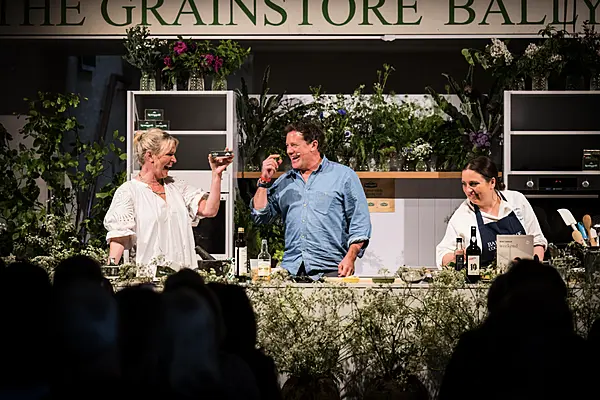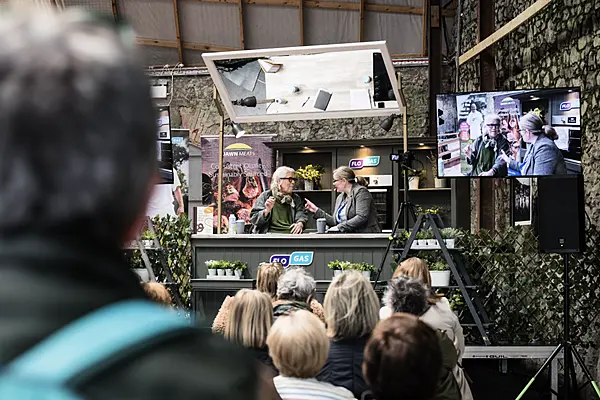Nick Lander ran the very successful L'Escargot restaurant in London until the toll on his health became too much. In a gamekeeper-turned-pocaher move, he then became restaurant reviewer for the Financial Times. Now he has brought all of this experience together in a masterful new book, The Art Of The Restaurateur . Emily Hourican met him.
Nick Lander is a perfect gentleman. He takes my coat, pulls out my chair and pours my tea, all with a kindly, twinkly sort of charm. He speaks and listens with courtesy, adding his own intelligent, perceptive take to any topic. In all, I can see just why he was once a great restaurateur, and is now a well-respected restaurant critic, who manages to have the confidence of the public, as well as the respect of the industry.
Actually, I think I might have guessed all this from his new book, The Art of the Restaurateur, beautifully published by Phaidon. Instead of a low-impact tell-all kind of a book, a series of reminisces about his time feeding Princess Diana and Mick Jagger, for example, this is a serious tome, a precise and indepth look at some of the greatest restaurants in the world, and an analysis of what it is they do so well.
Our own Ballymaloe is there, courtesy of a rare interview with Hazel Allen, in a chapter called The Ballymaloe Welcome, and when I ask Nick if there were any other Irish contenders for inclusion, he says “no,” then adds, politely, how much he loves this country. Other chapters are devoted to Danny Meyer, Nigel Platts-Martin, Juli Soler and Mark Saisbury, and cover topics such as classic neighborhood restaurants, design, affordable luxury and informal urban dining. Nick's clear and measured style mean that each interview is a piece of insight into the running of a really top-class establishement, whether at the Michelin-three-star end of formal luxury, or something more accessible and homely.
So how did the book come about? “I had always said I would never write a book,” he laughs, “because deadlines in the house are already terrible; my wife has written a number of books” – Nick, of course, is married to Jancis Robinson, OBE, wine reviewer for the Financial Times and author of The World Atlas of Wine and The Oxford Companion to Wine, among others – “and when they are due, a big black cloud hovers over the house.” However, for everything there is a season, of course, and so, “when Phaidon got in touch to ask whether I would consider it, somehow I just found myself typing back, two mins later, with the title of the book and 20 individuals I wanted to talk to, and they said yes.”
Nick's job, as he sees it, with the book “is to definitvely put people off if they can be put off, and to encourage them if they can't.” That said, this is not a How To type book for would-be restaurateurs, rather it is a much deeper look at what seperates a good establishment from a great one, what are the common denominators among those within the industry who are really excellent at their jobs. Rather than instruction, it serves as inspiration, and a record of the often-unsung efforts of these people. “The book is the result of 25 years of eating out experience. In a way, it's my tribute to the heroes of the business,” says Nick. “I was very conscious that these are individuals who have an awful lot to pass on, and that nobody was really going to ask them to pass it on; this is a transient business, people move around, even within family-owned places. These people are too busy to write their own memoirs, and in a way, too specific. So I felt a responsibility to do it.”
“The generosity of these restaurant owners and hoteliers, with their time and wisdom, was remarkable,” he says. “If I had written a book called The Art of the Accountant, or The Art of the Solicitor, how many accountants and solicitors would have given up their time, sat down and told me all about the mistakes they made?”
Much as I would love to witness someone trying to market a book called The Art of the Accountant, Lander is of course absolutely right. Restaurants sell, because there is inherent drama within the dynamic between kitchen and dining-room; wait staff and customers. So far, chefs seem to have collared more than their fair share of the attention however, stealing the limelight from restaurateurs, whose role is far less picturesque. It's a balance that Nick is consciously trying to redress with this book. “I want to encourage restaurateurs to believe in themselves, to believe that they are highly marketable. The thing is, they are at a disadvantage, because kitchens really are entracing places – the bustle, the steam, the clutter – you can point a camera at a chef in the kitchen for ten minutes, and it's all exciting and absorbing. A restaurateur repeats the same stuff every day – setting out, polishing cutlery – things that seem monotonously boring. For example, I was determined to interview Juli Soler from El Bulli, and Joe Bastianich who, with Mario Batali, owns 25 restaurants and three wineries in Italy. Feran Adria and Mario Batali would be the first to admit that without their counterparts, the restaurateurs, they would not have suceeded. And yet, in certain instances, the chefs have sucked up so much of the oxygen. This book is a conscious repositioning of the restaurateur. We've been so busy over the last few years watching chefs explode and chop things and roar at people, now it is time for the restaurateur to be seen.”
But let's go back a bit, to the days before Lander was restarant reviewer for the Financial Times, to when he had L'Escargot. In a way, he was an accidental restaurateur, falling into it with no professional experience whatsoever, because he needed a showcase for wines he was then importing. Having first worked as a commodities trader, Lander decided to try something new, different, on his own. And so he took on the UK agency for a Californain winery. The wines didn't sell, and so he came up with the idea of a little wine bar, somewhere people could sit, eat simply, try the wines at their leisure. This was London in 1980, wine bars were quite the thing. Instead, he ended up signing a lease on a five-story townhouse originally built for the third Duke of Portland, William Cavendish-Bentinck, also twice Prime Minister. “I was 27 or 28, I had had a few good years as a commodity broker, I had a small mortgage and no children, I felt strong. I fell in love with the building, and it was a very good deal.” So that was that. “When you're starting out,” he insists, “you need to get a lucky break. An inexpensive lease will compensate for the string of mistakes you are going to make in the first six or nine months! A little bit of a cushion, that's what that ultimately provided.”
The opening of L'Escargot coincided with the UK recession in 1981, and so took a while to really hit its stride. “The tide starts to turn when you see people coming back,” Nick says. “And when you know the margins are within an gnat's whisker of being right. It is very important to have a financial controller who doesn't have a sense of humour, who can look at the figures in black and white, disapssionately.” So what other qualities are necessary to run a good restaurant? “A sense of humour is the most important. And I loved being with people, looking after them. L'Escargot had been a private house, so there was that sense of welcoming people into your home. Also, I loved the idea I was learning so much about food and wine; the more you know, the more you realise there is to know. It was a great help being in the West End of London. There were a lot of international business close by, we were in the heart of theatre land, close to Channel 4. When you create something good, people will come to it, and that is a fantastic feeling. When you take a dead piece of property, in an underappreciated street, and because of what your team are doing, you're putting it on the map, that is a great feeling.”
This is a theme Nick returns to several times, one I also hear him discuss with Pat Kenny on RTE radio, “What restaurants do,” he explains, “is they are wonderful at reviving old buildings, providing a lease of life for them. Take Ballymaloe – how many people have passed through there and seen it? If it wasn't for the restaurant, it would have been a private house, and who would ever have seen it? Restaurants can also make bad neighborhoods good, because people go to them, then more people go and it becomes a beacon, then someone else opens a restaurant round the corner, and the whole area is transformed.”
As he rightly points out, for all that hoteliers and restaurateurs may give out about the internet, and random people posting their thoughts and reviews on-line, the hospitality industry has prospered greatly because of it. “Because this business isn't like retial. It can't move online. You have to actually go. You can't eat it on-line, you have to get up and actually go. This is why the market has carried on expanding.”
In the days of L'Escargot, Lander fed Princess Diana, Mick Jagger, Ella Fitzgerald and half of theatrical London; something he describes as “a blessing and curse,” although admitting that back then, “it was less of a curse than now; there were fewer restaurants and the newspapers were more restrained.” However, he describes the process of hosting a certain type of celeb as really quite painful. “There was a particular political journalist who did lot of high-profile interviews in the restaurant, for which he required a corner table, even though there were only two of them. Then, if it was an ambassador or similar, Scotland Yard would come in the day before to check the place out, and they would send a plainclothes policeman to sit and watch the interview, from a table-for-two nearby, which means you lose another cover and of course the policeman wouldn't drink...” This of course was in the days when TBLs - Two Bottle Lunches - were the norm, and an excellent source of revenue.”
Nevertheless, despite the hassle involved, from such encounters, L'Escargot rapidly built up both a strong following and aura of glamour. Something else that contributed to the successs of the venture was perhaps more prosaic, but just as important. “Channel 4 had their offices about ten minutes walk away, and they used the restaurant an awful lot. One day, the finance director – a very nice man – was in and we were chatting. I asked, 'why do you use us so much? After all, there are a lot of restaurants in the area?' He said, 'because you make a point of filling in the credit card slip with the service and so there is nothing left blank. I have a staff of several hundred, all with corporate credit cards, going out for lunch maybe four times a week. I can't have blank slips coming back.”
L'Escargot may have established itself as one of the most successful restaurants in London, but the toll it took in terms of health was considerable. By the time Lander sold, in 1988, he had been suffering from ulcerative colitis for many years. A spell in hospital forced him to confront the fact that if he was to carry on, the cost to his young family would be significant. “The decision to give up,” Lander says now, “was a very obvious one at the time. My health had reached a stage where there was no other option. It was tricky, because selling a restaurant isn't easy, and very hard for the first few months afterwards. I wasn't quite sure what I was going to do, I was sitting at home, picking up the phone and thinking, 'I must not answer it 'L'Escargot'...'. It was hard afterwards, you put everything into it and suddenly its gone. Also, I didn't realise how lucky I would be with the next stage of my career. Frankly, I thought it was all over, and that I would go round saying, 'I used to own this restaurant.'”
That next stage – writing his column, The Restaurant Insider for The Financial Times – has lasted over 20 years now, and he still displays the same enthusiasm, and scruples, as he ever did. “It is very easy to stick the knife in, and can make very good reading, but you have to balance that with something positive. If life is too short to stuff a mushroom, it is much too short to have a bad meal. You have to tell people where not to go, but also where is good to go? Give some suggestions and recommendations.”
Given his experience, Lander has a rather uniquely comprehensive view of the industry, from behind the scenes and out front. So what does he think of the industry as it is now, in particular the appetite for novelty and need for constant clever marketing among restaurants? “In the UK we still have a kind of immaturity,” he says. “Over the last 20 years we have come to love restaurants, but we still turn it into a drama. We're constantly looking for what's new, and so you have these pop-ups. The French and Italians wonder how on earth they can survive. These places pay rent on turnover, they pop up and then they pop down. Often they are slammed in first weeks, and can't cope, then it's all over once the next thing comes along. The worst thing a restaurant faces is peaks and troughs in demand. And high demand is not necessarily a measure of quality, it is a measure of novelty.”
“Marketing,” he says, “used to be a dirty word. Advertising was always the sign of a bad restaurant, or a McDonalds, but that's all changed now.”
Another significant change he has seen is: “we have spent the last 15 years wanting to be surprised and shocked by our food, and now, actually, we're surprised and shocked everything that's going on in the rest of the world, and so we see reataurants as a place that we can be looked after and not shocked. Food is going that way, its much more homely. We don't want things to pop or explode or tower. Danny Meyer, one of New York's greatest restaurateurs, describes a restaurant as a place where you can be served the kind of food that you couldn't get at home, in an ambiance that you would like at home. And the Irish are very good at this.” “We want to be looked after in a way. We felt confident in the past, so that didn't matter, but now it does. The chef cant do it, he's in the kitchen, behind swing doors, coping with multiple orders. I can't do that, I'm a huge admirer of chefs. But their responsibility stops at the kitchen door. They cant look after you. That is the restaurateur's job.” However, he is at pains to point out, “the chef-restaurateur interaction shouldn't be a fight. It has been made to look like a fight, because we're always looking for conflict. Conflict and drama make better copy. But I think there's enough conflict in the rest of the world, so let's just get on with running a great restaurant, a great hotel. A good restaurateur will make things as easy for the chef as possible. The other way – the fights, the drama and so on – is very, very macho.”
There are, he points out, “a lot of misunderstandings in the restaurant world, because customers don't explain what they want very well. Very few customers sit down and say, for example, 'we're here for business, we're going to order straight away, bring us the food and leave us alone.' Waiters arent mind readers, managers aren't mind readers. Its a very difficult encounter; the customer should be in charge as they are paying the bill. This book, I hope, will give those outside the business an insight into the business, so they can enjoy the experience better and maybe lay down a few ground rules.”
As much as a sense of humour is, Lander reckons, the most important quality to have when running a restaurant, it also comes into its own on the domestic front. Married to Jancis Robinson, with three grown-up children, Lander is one half of the UK's great food and beverage power couple. And yes, this does mean that friends think twice before inviting them to dinner. “They shouldn't, and they mustn't, but they do. Really though, its not what you eat and drink, its how you're looked after. If you go out of your way to source something really lovely, such as artisan cheeses, this is far more exciting than spending three hours stacking up a plate of vegetables.”
A perfect example of just how humour works in the Lander-Robinson household came a couple of weeks ago. Jancis' latest book, Wine Grapes, was chosen as one of the Books of the Year by the Guardian, and then, a day later, Lander's was similarly selected by the Sunday Times. 'One all!' tweeted Jancis.








